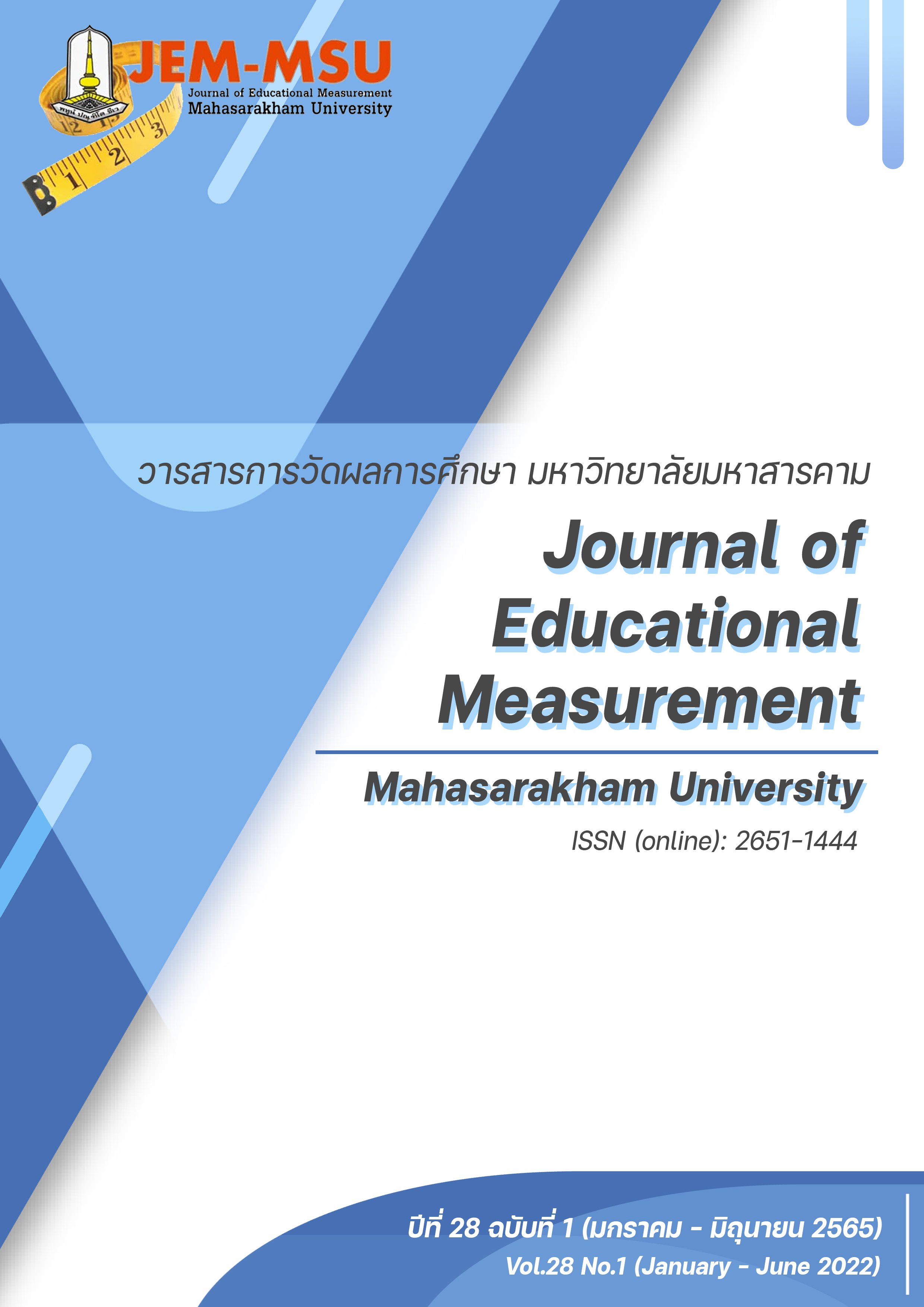โมเดลสมการโครงสร้างพหุระดับของการเรียนรู้แบบนำตนเองของนักศึกษาพยาบาล
Main Article Content
บทคัดย่อ
การวิจัยนี้มีวัตถุประสงค์เพื่อศึกษาอิทธิพลของการสนับสนุนทางสังคมของอาจารย์พยาบาลที่มีต่อรูปแบบการเรียนรู้และการเรียนรู้แบบนำตนเองของนักศึกษาพยาบาล ตัวอย่างวิจัย คือ นักศึกษาพยาบาล จาก 21 สถาบันการศึกษาพยาบาล จำนวน 371 คน ได้มาจากการสุ่มอย่างง่าย เก็บรวบรวมข้อมูลด้วยแบบสอบถามแบบมาตรประมาณค่า 5 ระดับ จำนวน 76 ข้อ ประกอบด้วย 1) รูปแบบการเรียนรู้ 2) การสนับสนุนของอาจารย์พยาบาล และ 3) การเรียนรู้แบบนำตนเอง โดยมีค่าความเที่ยงในระดับมากทุกองค์ประกอบ ( > .80) และการวิเคราะห์ข้อมูลด้วยโมเดลสมการโครงสร้างพหุระดับ (multilevel structural equation modeling: MSEM)
ผลการวิจัยพบว่า โมเดลสมการโครงสร้างพหุระดับมีความสอดคล้องกับข้อมูลเชิงประจักษ์
(2 (35) = 50.606, p = .048, CFI = .989, TLI = .984, RMSEA = .035, SRMRw = .015 และ SRMRb = .115) โดยโมเดลในระดับนักศึกษาพบว่า รูปแบบการเรียนรู้สามารถอธิบายความผันแปรของการเรียนรู้แบบ นำตนเองได้ร้อยละ 73.0 ส่วนโมเดลในระดับอาจารย์พบว่า รูปแบบการเรียนรู้ของนักศึกษาพยาบาล และการสนับสนุนทางสังคมของอาจารย์ สามารถอธิบายความผันแปรของการเรียนรู้แบบนำตนเองของนักศึกษาพยาบาลได้ร้อยละ 80.7 และผลการวิเคราะห์อิทธิพลพบว่า การเรียนรู้แบบนำตนเองของนักศึกษาพยาบาลได้รับอิทธิพลทางตรงจากการสนับสนุนทางสังคมของอาจารย์ แต่ไม่มีนัยสำคัญทางสถิติ (
= .134, p = .388) และมีอิทธิพลทางอ้อมผ่านรูปแบบการเรียนรู้ของนักศึกษาพยาบาล (
= -.594, p = .015) ดังนั้น การพัฒนาการเรียนรู้แบบนำตนเองของนักศึกษาพยาบาลควรเริ่มที่การจัดการเรียนการสอนให้สอดคล้องกับรูปแบบการเรียนรู้ โดยอาจารย์พยาบาลให้การสนับสนุนเพียงบางส่วน เพื่อให้นักศึกษาพยาบาลสามารถพัฒนาตนเองร่วมกันได้อย่างมีประสิทธิภาพ
Article Details

อนุญาตภายใต้เงื่อนไข Creative Commons Attribution-NonCommercial-NoDerivatives 4.0 International License.
เนื้อหาและข้อมูลในบทความที่ลงตีพิมพ์ในวารสารการวัดผลการศึกษา มหาวิทยาลัยมหาสารคาม ถือเป็นข้อคิดเห็นและความรับผิดชอบของผู้เขียนบทความโดยตรง ซึ่งกองบรรณาธิการวารสาร ไม่จำเป็นต้องเห็นด้วย หรือร่วมรับผิดชอบใดๆ
บทความ ข้อมูล เนื้อหา รูปภาพ ฯลฯ ที่ได้รับการตีพิมพ์ในวารสารการวัดผลการศึกษา มหาวิทยาลัยมหาสารคาม ถือเป็นลิขสิทธิ์ของวารสารการวัดผลการศึกษา มหาวิทยาลัยมหาสารคาม หากบุคคลหรือหน่วยงานใดต้องการนำทั้งหมดหรือส่วนใดส่วนหนึ่งไปเผยแพร่ต่อหรือกระทำการใดๆ จะต้องได้รับอนุญาตเป็นลายลักษณ์อักษรจากวารสารการวัดผลการศึกษา มหาวิทยาลัยมหาสารคาม ก่อนเท่านั้น
เอกสารอ้างอิง
Cox, L., Clutter, J., Sergakis, G., & Harris, L. (2013). Learning style of undergraduate allied health students: Clinical versus classroom. The Journal of Allied Health, 42(4), 223-228.
Frankel, A. (2009). Nurses' learning styles: promoting better integration of theory into practice. Nursing times, 105(2), 24-27.
Good, J. P., Ramos, D., & D’Amore, A. C. (2013). Learning style preferences and academic success of preclinical allied health students. The Journal of Allied Health, 42(4), 81-90.
Grasha A. & Reichman S. (1975). Workshop handout on learning styles. University of Cincinanati.
Hair, J. F., Black, W. C., Babin, B. J., & Anderson, R. E. (2010). Multivariate data analysis (7th ed.). Pearson.
Halin, K. (2014). Nursing students at a university - a study about learning style preferences. Nurse Education Today, 34(12), 1443-1449.
House, J. S., Kahn, R. L. (1985). Measures and concepts of social support: See Cohen & Syme: 83-108.
Hox, J. J., & Maas, C. J. (2001). The accuracy of multilevel structural equation modeling with pseudo balanced groups and small samples. Structural Equation Modeling, 8, 157-174.
Khandaghi, M. A., & Farasat, M. (2011). The effect of teacher's teaching style on students’ adjustment. Procedia-Social and Behavioral Sciences, 15, 1391-1394.
Knowles, M. S. (1975). Self-directed learning. Association Press.
Papastavrou, E., Dimitriadou, M., Tsangari, H., & Andreou, C. (2016). Nursing students’ satisfaction of the clinical learning environment: A research study. BMC nursing, 15(1), 44.
Soper, D. S. (2018). A-priori sample size calculator for structural equation models. Retrieved from http://www. danielsoper.com/statcalc
Aphanantikul, M., Thanurak, R., & Ruecha, Y. (2008). Development of a Self-Directed Learning Readiness Scale for Thai Undergraduate Nursing Students. Thai Journal of Nursing Council, 23(2), 52-69. (in Thai)
Chanchusakul, S., Rueangtrakul, A., & Tangtanakanon, K. (2014). Development of Cooperating Teachers’ Socail Support Scale for Student Teachers’ Professional Teaching Practice. Journal of Education Studies, Chulalongkorn University, 42(2), 131-147. (in Thai)
Jamjang, S., Attametakul, W., & Pitaksin, D. (2018). The Effect of Readiness Preparation for Nursing Practice in Ward of 2nd year Nursing Students, Borommarajonnani College of Nursing, Ratchaburi. Journal of Science and Technology, Ubon Ratchathani University, 20(3), 147-163. (in Thai)
Keeratiyutawong, P., Mahakayanan, S., Boonnet, N., & Angkaprasartchai, W. (2015). Learning Patterns of Nursing Student of Burapha University. Ramathibodi Nursing Journal, 21(3), 382-394. (in Thai)
Kuariyakul, A., Chidnayee, S., Wuttijureepan, A., Udonlert, M., Lorthamma, P., & Sripalakit, J. (2018). Evaluation on the Bachelor of Nursing Science Program, 2012 revision of Boromarajonani College of Nursing, Uttaradit. Boromarajonani College of Nursing, Uttaradit Journal, 9(1), 44-58. (in Thai)
Nantasaenee, S., Wongwisetkul, S., Sukcharoen, P., & Taechangkul, L. (2018). Development of Learning and Teaching Process for Nursing Student, Suan Dusit university. Boromarajonani College of Nursing, Uttaradit Journal, 10(2), 166-179. (in Thai)
Phokasem, B. (2015). Nursing Teacher and Happiness at Work. Nursing Journal of the Ministry of Public Health, 25(1), 13-24. (in Thai)
Sirirat, N. and Chidnayee, S. (2009). Effects of Teaching in Teams for the Subject, Nursing People with Health Problems, towards Learning Effectiveness and Critical Thinking of Students in Bachelor of Nursing Science Program. Journal of Health Science Research, 3(2), 32-40. (in Thai)
Sombattheera, K., & Thawornpitak, Y. (2015). Questionnaire Response Rate and Relevant Factors to Questionnaire Response Rate in Collecting Data by Sending Questionnaires via Mail in Nursing and Public Health Research Work. KKU Research Journal (Graduate Studies). 15(1), 105-113. (in Thai)
Sriboonpimsuay, W. (2014). Factors Influencing Self-Regulated Learning of Nursing Students of Boromarajonani College of Nursing, Udon Thani. Journal of Nursing and Education, 7(4), 78-91. (in Thai)
Thailand Nursing and Midwifery Council (2012). Third National Nursing and Midwifery Development Plan (2012 - 2016). Thailand Nursing and Midwifery Council. (in Thai)
Tokani, M. (2009). Problems and Demand in Consulting Service of Students in Faculty of Nursing, Princess of Naradhiwas University, Princess of Naradhiwas University Journal, 1(1), 80-92. (in Thai)
Wisuttipan, P. J. and Disorntetiwat, P. (2015). Learning Patterns of Nursing Student of Ramathibodi School of Nursing, Faculty of Medicine, Ramathibodi Hospital, Mahidol University. Nursing Journal of the Ministry of Public Health, 25(1), 70-82. (in Thai)
Yodthong, S., Saenee, N., & Chansoongnoen, J. (2018). Stress and Coping Strategies of Nursing Students in Clinical Practice on Wards in Principles and Techniques of Nursing Practical Course, Boromarajonani College of Nursing, Trang. The 9th Hatyai National and International Conference. 761-772. (in Thai)


